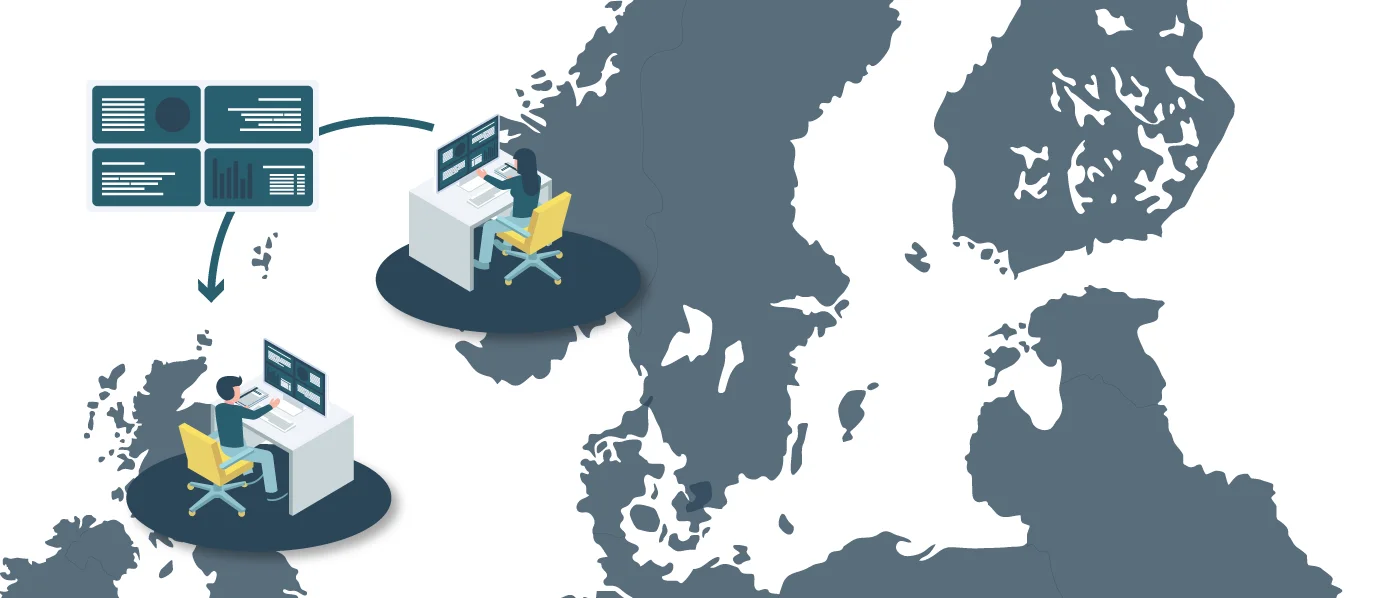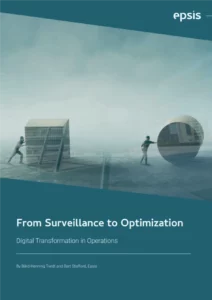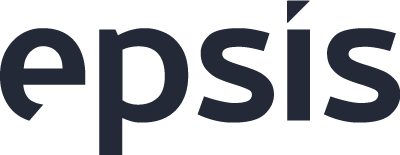OPERATIONS CENTERS
The Ultimate Guide to Building Successful Operations Centers
16 min read

An Operations Center, or simply an “OC,” is the capability developed by an organization to support operations occurring at remote sites. They are popular in the energy, mining, and construction industries to provide guidance, specialist knowledge, and cross-functional assistance to the “sharp end” of the business where space is at a premium due to geography or the desire to keep staff out of harm’s way.
A mission control center at NASA is an example of an OC; it is the location where all the system specialists are co-located with the data and communications systems to support the activity occurring in orbit. Many other industries have similar arrangements to channel collaboration with the aim of eliminating silos of expertise and improving operational efficiency alongside the center’s more clearly stated goals.
An OC is typically created to improve operations – the clue is in the name! However, centers can be made with other aims, and they all follow a similar model. A center can be designed to coordinate activities across multiple sites; these tend to supply a planning function, align activity or manage inter-site dependencies. Similar centers are created to provide a more traditional support-type function where subject matter experts are co-located to address longer-term optimization activities or be on hand to cope with unexpected changes. The information contained in this guide should be suitable for any use case or topology. We use the term “OC” throughout for readability, but you can substitute “Integrated Operations Center” (an “IOC”), “Integrated Remote Operations Center” (an “IROC”), “Support Center”, “Planning Center” or just “Center.”
Epsis has been helping build, improve and operate OCs for almost two decades, and over that time, we have seen many examples of successful centers as well as those proving more problematic. OCs have also been seen as massively costly exercises suited to well-heeled multinationals, but that is not necessarily the case; it is about smart spending with a clear understanding of how those costs will be recouped. A flourishing center can do this in a matter of weeks, making it a sound investment and improving the bottom line. OCs can be rolled out cautiously and incrementally if you are still developing a value case for them. There is no single solution that will fit all needs, but there are some excellent approaches to guide you to success.
Using our lessons learned, we have complied a list of top tips that you should find helpful to ensure your OC works effectively.
Focus 1: An operation center is not a room
Companies usually focus on “the OC,” a showcase room full of big screens, cool architecture, and eager, young engineers. This is a red herring; the room itself is rarely that important and often not needed. Some OCs can be completely virtualized, negating the need for a room at all. When the focus is a room, you can be sure it just becomes another silo in your business; a giant, shiny, expensive silo!
The OC serves the operation; those remote sites are part of the OC. Where the OC needs to interact with the broader business, they also become part of the OC. Any third parties involved in operational activities will become part of the OC. For every person “within the Core OC room,” you can be sure there are ten other people not in the room that are also part of the OC.
The capabilities provided by an OC; co-location, situational awareness, and collaborative technology can always be provided through a variety of means. What is important is to replicate those key features as needed across your operational delivery capability.
Surely that means the whole organization is “within the OC”? Perhaps, but unlikely! The scope can be managed in other ways to maintain focus, usually along with the concept of work timeframes. In addition, when designing OCs, we tend to work with the concept of a Core OC; the main “room,” operational management & all the connected remote locations it supports. In addition, we scope an Extended OC with the interface to the wider business, company leadership, and third parties not already in the Core OC.
Focus 2: Scope an operation center using timeframes
An OC is an active hub of business activity that is focused on letting the remote operational function “get on with the day job.” The OC has the capability to reflect on the bigger picture, to optimize, provide good tactical responses to emerging issues, consider cost-effectiveness or business value, to plan, to organize, to coordinate and enact longer-term strategic changes. An OC is designed to add the “smarts” to the operational function of your business as they are often bogged down in detail and dealing with current issues. The OC generally works slower than the remote site but faster than the central business traditionally operates.
So, scoping an OC by a timeframe usually makes things far easier: who goes into the center, how large it is, and what gets done in there are best driven by the timeframe it is supposed to work within. Functions and disciplines in most companies work within variable timeframes; some are working day to day, some are working on project timelines, and others are considering the best longer-term strategy. Keeping these timeframes within a function makes sense, but when dealing with the operational side of the business, only a subset of activities within each role or function needs to be considered.
Broadly every organization works in a series of time cycles. For example:

Within the hour: the “sharp end” of business, whether you are making widgets, producing oil, or constructing something. Problems manifest quickly and need to be swiftly resolved with safety, rather than cost, as the primary motivator. The expertise and responsibility for this activity should be on the remote site, and they need to be empowered to fulfill these operational needs as required. If these events become too costly or occur too often, then the organization will be in a constant state of “firefighting” (hopefully not literally!). This is usually a sign of endemic problems elsewhere in the organization, inadequate maintenance, logistics failures, lack of planning, bad data, or poor situational awareness. This timeframe is not suited for support by an operations center; as soon as you have to collaborate externally, you are not working “within the hour,” and you are building inefficiencies and creating more problems. An OC is not operational oversight – local on-site management provides that.
Within the day: this is typically where an OC operates. It allows the remote sites to focus on doing the work while the OC can concentrate on the bigger picture. Surveillance of data trends to support short-term optimization activities and managing responses to unplanned problems are often crucial requirements. Here teams do have the luxury of figuring out the “best way” of doing something, whether that is the most cost-effective, most efficient, or the one offering the best long-term benefits.
Within the week: Again, these are rich pickings for OC scope as you try to coordinate the weekly rhythms that occur on remote sites. These can take many forms, such as providing longer-term optimization activities between roles (logistics & preventative maintenance work, for example), coordination between sites (optimization of inter-site dependencies), and providing continuity between shifts and staff rotations.
Within the month: Here, the value to an OC begins to diminish as these timescales suit the pace of the wider business and generally fall under the remit of the central business functions. Work here tends to be more sales or project orientated, and any resultant on-site work can be added to a schedule or plan. If any of this work can rapidly impact the “focus for the day,” then those functions need to be closely linked to the OC – perhaps acknowledged as part of the Extended OC.
Within longer time frames: Rarely relevant for an OC.
A simple analogy may help. If you were tasked with managing a forest, the sharp end of the business is a forester who just needs to be told to fell trees within an area each day; they have the tools and expertise to do that safely and move on to the next tree. Any optimizations you make here are likely to be insignificant – a tree here or there. In this case, the OC will instead be focusing on the area to work on next, how to stop foresters from impacting each other, how to clear the felled trees efficiently, and get the wood to where it is needed as quickly and cheaply as possible before engaging a reforesting crew. Here every decision can be optimized, and any improvement will be significant. Whether those trees are sold as firewood or fine furniture is a slower cycle again, and that will not change how the OC works, the only impact being high-level strategic goals to harvest or replant a particular species of tree.
Most organizations already think like this when they do their planning, so much of this scoping can just be inherited. Each timeframe generally aligns with a standard planning horizon:
Today’s operating plan is the responsibility of the remote site; any interference with that plan will blunt the effectiveness of the operation and should be avoided. This is not OC territory.
The 7-day and 30-day plans generally align with daily activities and operational success. There is some flex available here to improve operational efficiency and tweak work to adapt to new operating conditions. These tend to align well with the Core OC scope.
The 90-day or 180-day plans generally align with weekly cycles and longer-term project activities. These will be relevant to the Extended OC or those centers that focus on preventative maintenance & longer-term optimizations.
Annual or multi-year plans tend to align with monthly cycles and larger one-off projects. These focus more on sales & strategy, with long-term initiatives and improvements that are generally out of the scope of OCs.
Never put whole functions in your Core OC; just those one or two individuals or roles within that function that deal with daily operational matters. Those members of a function who frequently coordinate with the operational end can stay with the central team but be regarded as being in the Extended OC. Being able to analyze the collaboration between functions and the roles within those functions is a vital tool in helping to scope an OC as it gives insight into the timeframes they work; any collaboration mapping tools or methodologies can be adopted to help do this.
Also – you will get it wrong! An OC is a learning process; things will change, and that is the nature of the beast. Hence the need for further design considerations.
Other types of centers may work on slightly longer timescales, but the same approach can be used to decide who would sit in the OC. For example, an expertise center supporting fleets of vehicles or machinery tend to work on slower timeframes but across a wider set of remote sites. They will have their own operating cadence, and the center should be staffed by people working within the same timeframes.
Since one of the main aims of an OC is to break down silos and allow freeform collaboration between functions, it cannot be too large. Freeform collaboration can really only occur to people within eyesight of each other (whether physically or virtually) and expecting anyone to maintain a collaborative working relationship with more than a few people is tricky. Most successful OCs are in the 10-30 people range. By all means, have several centers in close proximity to each other to create a bigger facility – but each should be scoped separately, and they effectively become Extended OCs to each other.
Focus 3: Keep it simple
OC projects tend to overstep their boundaries and risk becoming overblown with complexity and cost. Kicking off an OC initiative means that someone high up in the organization is generally willing to spend money on a somewhat ambiguous scope full of hope and promise.
It is pretty astonishing how many initiatives and parallel projects suddenly appear out of the woodwork and try to hitch their wagons to the OC. Some of these may well be highly relevant, but most are not. You will also be amazed at how many new technologies the IT department has wanted to unleash on the workforce, dashboards, data warehouses, and new visualization tools. If they are strong candidates for improvement, they should be separate projects. Your AV provider has a giant book of amazing new collaborative technologies they think you should design into the space to help improve things; you can maybe afford to take on one or two of the more compelling ones but don’t buy into the hype.
The OC will introduce enough change for most staff to cope with, and they will become very resistant to new ways of doing things they can do already. The prime focus of an OC rollout should be around getting people to evolve new ways of working, break down the silos and be reactive to the needs of the remote sites. Fancy new ideas and “amazing” technology distract from this, overloads people, and can create further information divides. All these are barriers rather than improvements.
Focus on making better use of the tools you already have. Utilizing the full capabilities of your existing technology is often overlooked. Your current applications will have evolved and improved since you started using them; programs like MS Teams can suit an OC very well if properly adopted. This way, you bring in new capabilities with little added complexity as your teams will be familiar with them already. Avoid bringing in new dashboards, portals, and such until your OC’s new ways of working have bedded down. These tools require active management to stay relevant and tend to proliferate out of control if you are not careful; soon, you will need a dashboard for your dashboards and then a dashboard for your dashboard dashboards.
Adapting work within an OC rarely needs new technology; however, there are some use cases where it would be required. These tend not to be fancy or complex:
- Gaps in instrumentation or data; an OC relies on a flow of good data. Any gaps or problems will prove problematic and require resolution. This may be missing or poor instrumentation or simply badly structured data. This includes human-generated data – such as action logs and manual readings. Avoid “fixing” data that is already fit for purpose; those types of projects can take years!
- Improve existing collaboration tools; better quality VC and the possibility of some “always on” cameras to provide virtual co-location. Avoid new tools with a learning curve; consider introducing things like Smartboards later if you feel they will add value.
- Consider introducing technology to support the use of existing tools if they don’t contribute additional complexity. Epsis Enify is a useful application in this space as it can guide users to use the preferred applications and data sets in the context of the work they are undertaking. It also can be used to drive users to use the less explored aspects of the existing tools.
An OC should be used to introduce innovative ideas and technologies into the company, but do them later. Maintain awareness of change saturation by listening to the feedback of your user community and advancing when they are reasonably comfortable with the current state. Everyone is resistant to change, so a bit of discomfort is fine, but introduce change gently over time rather than inflict it all at once.
Yes, an OC also needs active ongoing management and technical business support. These are two new roles you will need to create.
Focus 4: Capture work dynamically to build a culture of change
You will rightfully expect work practices to change in an OC; that is why you are building the thing! However, it is crucial to understand that this is an evolutionary process as the new collaboration tools, information, and technology are fully adopted and used effectively. Everything that occurs within an OC should be regarded as a learning process and subject to continuous improvement.
Don’t try and analyze all the business processes beforehand and spend a lot of time re-engineering them for the OC. This can take years and end up becoming a blocker to change rather than an enabler. What happens within an OC already occurs in the business. The Subject Matter Experts (SMEs) involved know how to do their job; they just need to learn how to re-engineer their work to take advantage of the environment to maximize efficiency, build solid working relationships between sites and adopt the best tools and ideas.

This is far easier done whilst doing the work than in advance. Do not put in place processes for the work itself. Instead, focus on putting in strategies to create a continuous learning environment. Have a means for SMEs to capture the way they do the job currently and then be able to evolve those in their own time to create new ways of working. Then ensure they are shared between those that need to use them to provide consistency and repeatability; everyone conducting the work should be able to contribute to its improvement dynamically. Less experienced staff, alternate shifts, and holiday cover can pick up these ways of working to continue to perfrom work to the accepted standard. There are many ways to achieve this, but one of the simplest is to adopt a tool like Epsis Enify to let the SMEs create self-documenting, shared “ways of working”; it can pull together the data, tools, and guidance within a simple work task definition that anyone can adopt and adapt as needed.
Staff selection becomes particularly important to make this work; innovative self-starters who are not happy with the status-quo are prime candidates. Within an established workforce, these individuals can be pretty disruptive as they will tend to challenge the regular order. In a traditional environment, they can become quite disheartened at the lack of change, but within an OC, an environment built for change, they can thrive. Finding and supporting these people can be hugely different across different world cultures, so there are times you must deliberately cultivate behaviors that don’t come naturally.
With OCs, people often talk about it bringing together “people, process & technology,” but this is not enough. An OC brings a new environment to the game, and you expect to create a culture of change. So, it becomes “people, process, technology, environment & culture.” This way, you can ensure the OC becomes a vehicle for substantial and continuous business improvement. If not, it just becomes a fancy room to complete the same old work and is not worth the investment.
Focus 5: No black mirrors
A screen, when off, looks like a black mirror and serves no purpose. If you are paying for the screen and the power to run it, then it needs to serve a purpose for anyone who may be nearby, even if just passing.
Generally, screens have an active use defined for them to justify their purchase; for my computer, information support for meetings, VC screens, and information displays to maintain situational awareness of machinery status or production rate. When a screen is not being used actively, it should be utilized as a passive information source to spread situational awareness information across the workforce. They can be used to show the machinery status to a broader audience, show plans, action trackers, operations logs, priorities for the day, weather data, OC success information, general trends, news, and relevant social information.
Shared situational awareness is something that OCs are built to provide. It is far more efficient for people to see a problem manifesting as they grab a coffee rather than finding out when someone remembers to tell them. They may not have to take any immediate action, but being aware of potential issues coming down the line is invaluable. It also helps pull together a sense of community and joint responsibility, helping break down silos of work. No information within an OC should be privileged or “hidden” as everyone in the IOC is there to collaborate.
This not only includes the large screens rolled out across the environment but every personal screen across the center. Is a tumbling company logo of value? Nope, but some of the information you look at daily popping up as a screensaver should be useful to your colleagues when passing by and yourself when you are reading a paper document at your desk.
Although an OC should be a relatively open space for company employees to pass through, you should remain cognizant of the fact it is a dynamic working environment, and some of the information on the screens could be valuable to competitors. A single snapshot of information without context as a visitor passes through the center is unlikely to be a problem, but screens should not be continuously viewable by anyone who has not signed your company’s NDA and security/privacy policy. Maintain awareness of confidential information and possible information bleed but avoid becoming paranoid about it.
One final note on screens; don’t buy into expensive blended screens or massive video walls; they are just not necessary these days and are rarely worth the money. 4K screens up to 80″ are cheap, ubiquitous, and can have tiny bezels, all the things you could only get on “high-end hardware” only a few years ago. There are many better things to spend your money on than unnecessarily expensive displays.
That is not to say all screens are equal; depending on your use case, you may need to buy professional grade displays for color accuracy or to provide 24/7 operation. You may have a genuine use-case for a giant video wall, or you may just wish to have a facility that looks very slick and high-end; these are all good reasons but do not let your AV provider sucker you into purchasing anything more than you want or need.
Indeed, much of the time, you can probably get away with consumer-grade screens if your center is only operating 8-hour days as it is cheaper to go to Costco and throw up a new screen when something breaks than to get anything more robust.
We urge you to follow the “Keep it simple” mantra for what sits behind the screens and drives them as well. A workstation PC with Windows can drive dozens of screens with relative ease without the need for scalers, matrix switchers, and other esoteric and inflexible video hardware. It is also simpler to manage and fix without resorting to AV specialists. Everyone knows how a PC works, and you can manage the screen real estate using simple software rather than expensive hardware that will leave you with another learning curve to conquer. We have seen many facilities where the advanced features of these screens remain unused as no one wants to engage with a weird touch panel on the wall to do anything but turn it on and off. Again, a tool like Epsis Enify can help manage screen content; particularly useful if you need to quickly throw up dozens of familiar applications across multiple displays with a single mouse click.
Focus 6: Sound is your enemy
Not something we need to dwell on but something worth mentioning as it is usually forgotten about until too late!
Designing the visual side of an OC is relatively straightforward; sight lines, screen sizes, and resolutions are all manageable concepts that can be done upfront with the help of your AV provider.
The audio side is a different beast, and it will be an issue. Unless you take it into consideration at the beginning, it will turn around and bite you.
An OC is a relatively open space to encourage collaboration in both a formal and informal capacity. Walls are great at creating silos. Walls are also great at stopping sound. So, the sound will propagate across the center. Unless carefully managed, this can disrupt not only the people working in the center but anyone conferencing into the facility.
Spend money on the technology & expertise to help here: directional speakers, multiple microphone arrays, zoned sound masking, echo cancellation, soft furnishings & sound baffling. Expect to spend some time and money after rollout to take the opportunity to “tune” the environment. This can only be done when people are in the center as people create, absorb and scatter sound.
Consider video conferencing facilities to support one-to-one (headset), team to the site (directional speakers & directional microphones), and many-to-many (standard speakers and microphone arrays).
Get the professionals involved here. Your AV provider can be largely bypassed on the screen-side, much to their chagrin, but their ability to provide help on the sound side is irreplaceable. Validate their capability in audio design and determine whether they are up to the task before engaging them to help.
Again, employee selection is essential here; some people work well in a “buzzing” environment, and they are a great fit. An OC will not suit those who demand peace and quiet as it has been built as a collaborative environment, and collaboration cannot occur in silence.
Focus 7: Build in flexibility
As you will have gathered from everything you have read above, flexibility in all things is a priority. Everything will evolve over time as you get to grips with the OCs’ developing capability and how it can best help with changing business demands. The work done in the center, how it is done, and the people in the center will change. Embrace the chaos!
Deal with the ambiguity and avoid overdesigning the facility by keeping it simple and modular.
Humans are simple creatures, and we tend to perform best in teams of just 3-5 people. Within an OC where you are mixing disciplines, this is quite a practical number too. Maintenance needs someone who knows the machines, someone who manages the spares, and someone to get the spares and people together. Optimization activities may require 2-5 engineers doing similar tasks across different elements of the facility, taking into consideration each other’s constraints. You can probably build small collaborative clusters of “useful functionality” across your more important use cases. Each cluster will collaborate as a team together with shared information on large screens in front of them and VC with the remote facilities they are supporting, providing a dual use of the screens.
This is fortunate as large screens tend to be viewable by people only a few meters away. By the time you pull together sight lines and viewing distances, the practical limit is 2-4 people clustered around a pair of large screens.
Our experience has shown that however you slice and dice your needs, you will always tend to fall back to a similar arrangement. We call these pods or modules. If you have a need for 5 or 6 people to collaborate periodically actively, then place the two modules beside one another.
Working with a series of identical 3-4 person modules removes complexity from the solution design as you create standalone modules with their own screens and desks and replicate them across the available floor space. There will be a natural connection between work occurring on each module that will guide which module to place next to which. For example, production sits next to optimization, sits next to maintenance, sits next to planning, and sits next to logistics.
They don’t need to be fully populated on day one, as this provides additional flexibility to shuffle people around as needed. As each module is independent of the others, the content of the giant screens in front of it will be driven by the people who sit around it. And they can move that to a new module as needed taking their content with them. Something that Epsis Enify can help streamline.
That pretty well deals with the people that work full time in the OC, but there are other use cases of the facility where you do need to pull groups together in a more transitory manner. Having a few meeting rooms for larger groups to gather with some privacy makes sense. Having a single large area in the middle of the facility is often a practical consideration for multi-site, multi-functional meetings to take place for large-scale planning or information sharing sessions. This is not used all the time so keep it open to reduce its footprint, promote deliberate information bleed to the modules around it, and allow its large screens to be used for passive situational awareness by everyone in the center.
Finally – ensure it is a pleasant place to work; these people are already dealing with constant noise and distraction, so they need places to relax, unwind and gather their thoughts. You will find gaps in your floorplan where you can place some soft furnished areas, refreshment facilities, huddle areas, focus rooms, and “show off” features.
What about the Extended OC?
Towards the beginning of this document, we introduced the concept of an Extended OC made up of those who collaborate with the individuals within the Core OC on a regular basis but are not heavily involved in the activities occurring within the normal OC timeframe. People within the Core OC are there because they must collaborate dozens of times a day with others in the Core OC (which includes the remote sites) and need visibility of events as they unfold in real-time to provide their expertise and insight to steer around constraints and other problems that inevitably occur.

The concept of the Extended OC is to support the Core OC in a similar way the Core OC supports the remote sites. Invaluable and necessary insight exists within the wider organization that needs to feed into the Core OC on a daily basis. If the operational engineer is within the Core OC, much of the rest of his engineering team will exist in the Extended OC; they will perhaps need to collaborate once or twice a day but generally stay out of the rough and tumble of the hour-to-hour operations. The Core OC effectively provides the vanguard of engineering capability of the broader organization.
The existing collaboration mapping exercise should provide a good starting point for the Extended OC scope, but it is just a starting point that will change fast and requires little up-front design. Initially, it just needs to be acknowledged as existing and you can afford to delay putting much effort into it’s development until Core OC is up and running.
The Extended OC just exists within the regular business at a standard desk; it does not need to be close to the Core OC, but proximity would help encourage some periodic and valuable face-to-face engagement. You don’t need all the sound design and big screens, but we would recommend that members of the Extended OC have the following changes made:
- Tweak job descriptions to include supporting the Core OC.
- Provide desktop-based VC capabilities (quality camera, quality headset), so they can actively collaborate with the Core OC easily and occasionally with the remote site if they cannot make it into the Core OC.
- Set up a matching desktop screen arrangement to those in the Core OC. Sharing screens or ways of working will be necessary to explain issues and work through problems. Having a one-to-one pixel match between collaborators saves a lot of headaches.
- They have access to the same information, data, and ways of working as those in the Core OC. These will not be needed very often, but being able to see what the OC sees at the same time will shortcut many blockers to effective collaboration.
These arrangements hold true for the remote sites communicating to the Core OC if they don’t have full-blown OC capability. Allowing everyone to see the same worldview in the same way, is a cornerstone requirement for successful collaboration; you need to be able to compare apples to apples with ease.
Is that it?
Yes, pretty much! You don’t need a “big-bang” project that takes over half your building. The flexible requirement means you can approach building OCs gradually, incrementally, and cost-effectively. The main requirements are a few screens, the right people and a willingness to change your ways of working.
The two mistakes we see companies make most often when designing an OC are:
- Building it as a tech showcase and not thinking enough about the work going on within it. We call this the “Build it, and they will come!” approach. They don’t come! People who work in these facilities don’t take full advantage of the cool tech and pretty well continue to work in the same way as they did before. This focus on the physical facility and not the collaboration is putting the cart before the horse. You are trying to create “One Team,” not “One Room,” and anything that does not directly contribute to this aim is of little value.
- The facilities are designed for “a purpose.” By the time it is built and occupied, that purpose has evolved, and the needs have changed. The facility kind of works as intended but never truly delivers on its promise of improving the company in any significant way as they lack the flexibility to adapt.
The reality is that you are designing for ambiguity, evolution, and for emergent collaboration. Embrace this and lean into these as requirements and deploy your OC with simple practicality and ongoing flexibility to continually reinforce a shared worldview of your operations.
We hope this high-speed journey through some of our design principles was helpful and makes sense. If you have any further questions or want to dive into the details of any of this content, get in touch.


